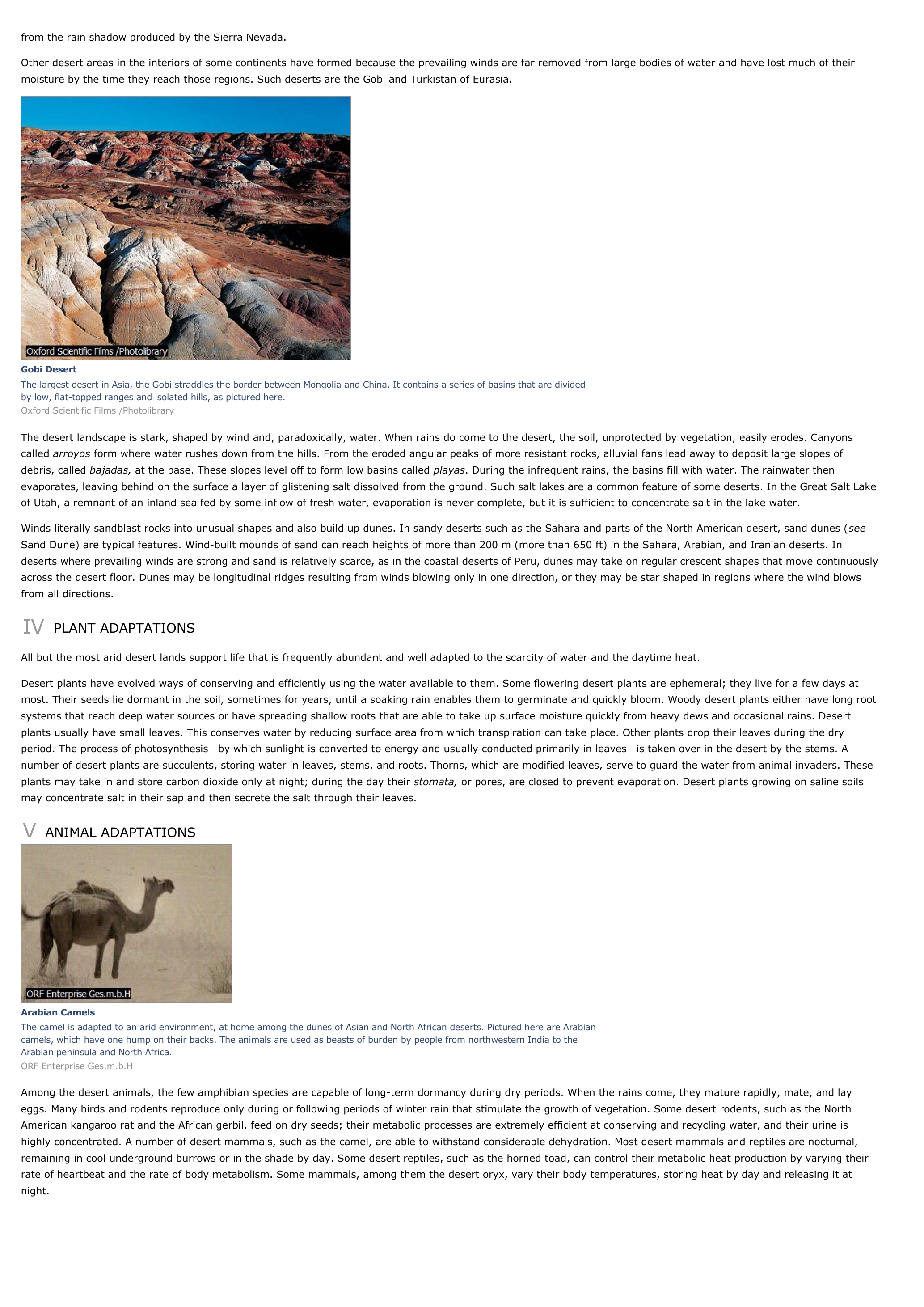Desert - geography.
Publié le 26/05/2013
Extrait du document
«
from the rain shadow produced by the Sierra Nevada.
Other desert areas in the interiors of some continents have formed because the prevailing winds are far removed from large bodies of water and have lost much of theirmoisture by the time they reach those regions.
Such deserts are the Gobi and Turkistan of Eurasia.
Gobi DesertThe largest desert in Asia, the Gobi straddles the border between Mongolia and China.
It contains a series of basins that are dividedby low, flat-topped ranges and isolated hills, as pictured here.Oxford Scientific Films /Photolibrary
The desert landscape is stark, shaped by wind and, paradoxically, water.
When rains do come to the desert, the soil, unprotected by vegetation, easily erodes.
Canyonscalled arroyos form where water rushes down from the hills.
From the eroded angular peaks of more resistant rocks, alluvial fans lead away to deposit large slopes of debris, called bajadas, at the base.
These slopes level off to form low basins called playas .
During the infrequent rains, the basins fill with water.
The rainwater then evaporates, leaving behind on the surface a layer of glistening salt dissolved from the ground.
Such salt lakes are a common feature of some deserts.
In the Great Salt Lakeof Utah, a remnant of an inland sea fed by some inflow of fresh water, evaporation is never complete, but it is sufficient to concentrate salt in the lake water.
Winds literally sandblast rocks into unusual shapes and also build up dunes.
In sandy deserts such as the Sahara and parts of the North American desert, sand dunes ( see Sand Dune) are typical features.
Wind-built mounds of sand can reach heights of more than 200 m (more than 650 ft) in the Sahara, Arabian, and Iranian deserts.
Indeserts where prevailing winds are strong and sand is relatively scarce, as in the coastal deserts of Peru, dunes may take on regular crescent shapes that move continuouslyacross the desert floor.
Dunes may be longitudinal ridges resulting from winds blowing only in one direction, or they may be star shaped in regions where the wind blowsfrom all directions.
IV PLANT ADAPTATIONS
All but the most arid desert lands support life that is frequently abundant and well adapted to the scarcity of water and the daytime heat.
Desert plants have evolved ways of conserving and efficiently using the water available to them.
Some flowering desert plants are ephemeral; they live for a few days atmost.
Their seeds lie dormant in the soil, sometimes for years, until a soaking rain enables them to germinate and quickly bloom.
Woody desert plants either have long rootsystems that reach deep water sources or have spreading shallow roots that are able to take up surface moisture quickly from heavy dews and occasional rains.
Desertplants usually have small leaves.
This conserves water by reducing surface area from which transpiration can take place.
Other plants drop their leaves during the dryperiod.
The process of photosynthesis—by which sunlight is converted to energy and usually conducted primarily in leaves—is taken over in the desert by the stems.
Anumber of desert plants are succulents, storing water in leaves, stems, and roots.
Thorns, which are modified leaves, serve to guard the water from animal invaders.
Theseplants may take in and store carbon dioxide only at night; during the day their stomata, or pores, are closed to prevent evaporation.
Desert plants growing on saline soils may concentrate salt in their sap and then secrete the salt through their leaves.
V ANIMAL ADAPTATIONS
Arabian CamelsThe camel is adapted to an arid environment, at home among the dunes of Asian and North African deserts.
Pictured here are Arabiancamels, which have one hump on their backs.
The animals are used as beasts of burden by people from northwestern India to theArabian peninsula and North Africa.ORF Enterprise Ges.m.b.H
Among the desert animals, the few amphibian species are capable of long-term dormancy during dry periods.
When the rains come, they mature rapidly, mate, and layeggs.
Many birds and rodents reproduce only during or following periods of winter rain that stimulate the growth of vegetation.
Some desert rodents, such as the NorthAmerican kangaroo rat and the African gerbil, feed on dry seeds; their metabolic processes are extremely efficient at conserving and recycling water, and their urine ishighly concentrated.
A number of desert mammals, such as the camel, are able to withstand considerable dehydration.
Most desert mammals and reptiles are nocturnal,remaining in cool underground burrows or in the shade by day.
Some desert reptiles, such as the horned toad, can control their metabolic heat production by varying theirrate of heartbeat and the rate of body metabolism.
Some mammals, among them the desert oryx, vary their body temperatures, storing heat by day and releasing it atnight..
»
↓↓↓ APERÇU DU DOCUMENT ↓↓↓
Liens utiles
- Kalahari Desert - geography.
- Namib Desert - geography.
- Sonoran Desert - geography.
- Desert - geography.
- Desert - Geography.

































